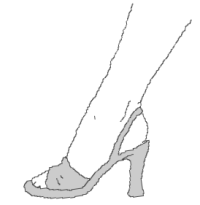 Just before you’d read this sentence, were you consciously aware of your left foot? Eric Schwitzgebel set out to resolve the question in the latest edition of the JCS.
Just before you’d read this sentence, were you consciously aware of your left foot? Eric Schwitzgebel set out to resolve the question in the latest edition of the JCS.
In normal circumstances, we are bombarded by impressions from all directions. Our senses are constantly telling us about the sights, sounds and smells around us, and also about where our feet are, how they feel in their shoes, how hungry we currently feel, whether our sore calf muscle is any better at the moment; and what spurious reasoning some piece of text on the internet is trying to spin for us. But most of the time, most of this information is ignored. In some sense, it’s always there, but only the small subset of things which are currently receiving our attention are, as it were, brightly lit.
There’s little doubt about this basic scenario. Notoriously, when we drive along a familiar route, the details drop into the background of our mind and we start to think about something else. When we arrive at our destination, we may not remember anything much about the journey: but clearly we could see the road and hear the engine at all relevant times, or we probably shouldn’t have been able to finish the journey. On the other hand, suppose as we were driving along, the sound of a baby crying had unexpectedly drifted over from the back seat: would we have failed to notice that feature of the background?
So we have two (at least two) levels of awareness going on. Schwitzgebel poses the question: which do we regard as conscious? On the “thin” view, we’re only really conscious of the things we’re explicitly thinking about. No doubt the other stuff is in some sense available to consciousness, and no doubt bits of it can pop up into consciousness when they trigger some unconscious alarm; but it’s not actually in our consciousness. How else, the thinnists might ask, are we going to make the distinction between the two different levels? The rich view is that everything should be included: I may not be thinking about my foot at all times, but to suggest that I only know where it is subconsciously, or unconsciously, seems ridiculous.
Schwitzgebel does not think either side has particularly strong arguments. Both are inclined to provide examples, or assert their case, and expect the conclusion to seem obvious. Searle has argued that we couldn’t switch attention unless we were conscious of the thing we were switching our attention to: Mack and Rock have done experiments to prove that while paying close attention to one things we may fail to notice other things: but neither of these lines of discussion really seems to provide what you call a knock-down case.
Accordingly, with many reservations, Schwitzgebel set up an experiment of his own. The subjects wore a beeper which went off at a random period up to an hour after being set: they then recorded what they were conscious of immediately beforehand (it’s important, of course, to keep the delay minimal, otherwise the issue gets entangled with problems of memory). The subjects were divided into groups and asked to focus on tactile, visual and total sensory experience.
The results supported neither the thin nor the rich position. Perhaps the most interesting finding is the degree of surprise evoked in the subjects. In a departure from normal experimental method, Schwitzgebel used as subjects philosophy postgrads who could reasonably be expected to have some established prejudices in the field: he also spent time explaining the experiment and talking over the issues, and recorded whether each subject was a thinnist or richist at the start. Although this involved some risk of skewing the results, it allowed the discovery that thinnists actually often found themselves having rich experience, and vice versa.
Where does that leave us? It seems almost as though the dilemma is merely reinforced: the research points towards some compromise, but it’s hard to see where we can find room for one. The results did seem to reinforce the existing general agreement that there really are two distinct levels or aspects of consciousness at work. Wouldn’t one solution, then, be to give both neutral labels (con-1 and con-2?) and leave it at that? That may be what one of Schwitzgebel’s subjects, who apparently dismissed the whole thing as ‘linguistic’ had in mind. But it’s not a very comfortable position to dismiss the concept of consciousness in favour of two hazy new ones. Schwitzgebel, rightly, I think, considers that the difference between thinnism and richism is real and significant.
My best guess for a neatish answer is that we’re simply dealing with pure first order consciousness and the same thing combined with second order consciousness. In other words, the dim constant awareness of everything being reported by our senses, really is conscious, but it’s a region of consciousness we’re not conscious of being conscious of. By contrast, we’re not only conscious of the things at the forefront of our minds, we’re also aware of being conscious of them. (It might well be that second-order consciousness is what animals largely or wholly lack – I wonder if thinnists also tend to be sceptics about animal consciousness?)
Alas, that’s not really a compromise: it seems to make me a kind of richist.

I have discovered this blog by means of another interesting blog called Psicoteca, and I think conscience is a really exciting subject also discussed in my personal blog, so I have decided to put the link of this web page in my blog.
Congratulations!